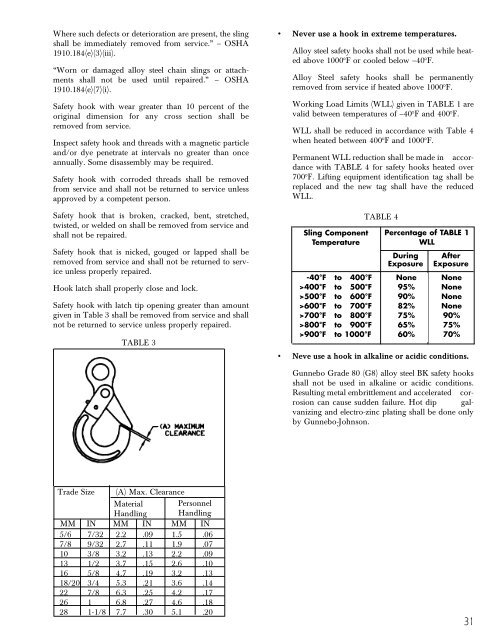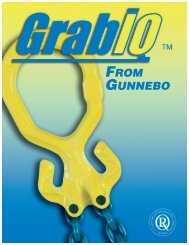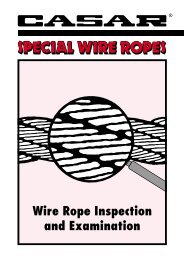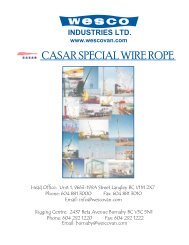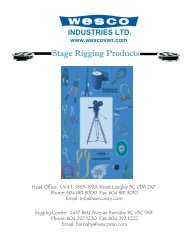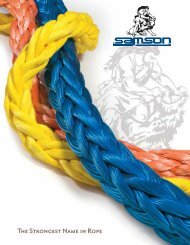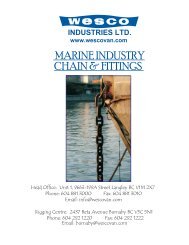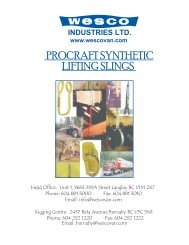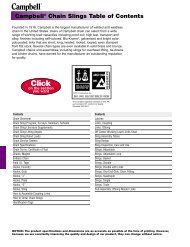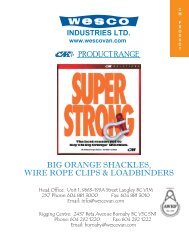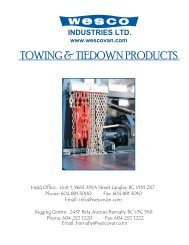Create successful ePaper yourself
Turn your PDF publications into a flip-book with our unique Google optimized e-Paper software.
Where such defects or deterioration are present, the sling<br />
shall be immediately removed from service.” – OSHA<br />
1910.184(e)(3)(iii).<br />
“Worn or damaged alloy steel chain slings or attachments<br />
shall not be used until repaired.” – OSHA<br />
1910.184(e)(7)(i).<br />
Safety hook with wear greater than 10 percent of the<br />
original dimension for any cross section shall be<br />
removed from service.<br />
Inspect safety hook and threads with a magnetic particle<br />
and/or dye penetrate at intervals no greater than once<br />
annually. Some disassembly may be required.<br />
Safety hook with corroded threads shall be removed<br />
from service and shall not be returned to service unless<br />
approved by a competent person.<br />
Safety hook that is broken, cracked, bent, stretched,<br />
twisted, or welded on shall be removed from service and<br />
shall not be repaired.<br />
Safety hook that is nicked, gouged or lapped shall be<br />
removed from service and shall not be returned to service<br />
unless properly repaired.<br />
Hook latch shall properly close and lock.<br />
Safety hook with latch tip opening greater than amount<br />
given in Table 3 shall be removed from service and shall<br />
not be returned to service unless properly repaired.<br />
TABLE 3<br />
Trade Size (A) Max. Clearance<br />
Material Personnel<br />
Handling Handling<br />
MM IN MM IN MM IN<br />
5/6 7/32 2.2 .09 1.5 .06<br />
7/8 9/32 2.7 .11 1.9 .07<br />
10 3/8 3.2 .13 2.2 .09<br />
13 1/2 3.7 .15 2.6 .10<br />
16 5/8 4.7 .19 3.2 .13<br />
18/20 3/4 5.3 .21 3.6 .14<br />
22 7/8 6.3 .25 4.2 .17<br />
26 1 6.8 .27 4.6 .18<br />
28 1-1/8 7.7 .30 5.1 .20<br />
• Never use a hook in extreme temperatures.<br />
Alloy steel safety hooks shall not be used while heated<br />
above 1000°F or cooled below –40°F.<br />
Alloy Steel safety hooks shall be permanently<br />
removed from service if heated above 1000°F.<br />
Working Load Limits (WLL) given in TABLE 1 are<br />
valid between temperatures of –40°F and 400°F.<br />
WLL shall be reduced in accordance with Table 4<br />
when heated between 400°F and 1000°F.<br />
Permanent WLL reduction shall be made in accordance<br />
with TABLE 4 for safety hooks heated over<br />
700°F. Lifting equipment identification tag shall be<br />
replaced and the new tag shall have the reduced<br />
WLL.<br />
Sling Component<br />
Temperature<br />
-40°F to 400°F<br />
>400°F to 500°F<br />
>500°F to 600°F<br />
>600°F to 700°F<br />
>700°F to 800°F<br />
>800°F to 900°F<br />
>900°F to 1000°F<br />
TABLE 4<br />
Percentage of TABLE 1<br />
WLL<br />
During<br />
Exposure<br />
None<br />
95%<br />
90%<br />
82%<br />
75%<br />
65%<br />
60%<br />
After<br />
Exposure<br />
None<br />
None<br />
None<br />
None<br />
90%<br />
75%<br />
70%<br />
• Neve use a hook in alkaline or acidic conditions.<br />
Gunnebo Grade 80 (G8) alloy steel BK safety hooks<br />
shall not be used in alkaline or acidic conditions.<br />
Resulting metal embrittlement and accelerated corrosion<br />
can cause sudden failure. Hot dip galvanizing<br />
and electro-zinc plating shall be done only<br />
by Gunnebo-Johnson.<br />
31


